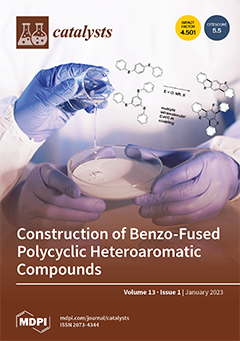Non-heme manganese(II) complexes [(IndH)Mn
IICl
2] (
1) and [(N4Py*)Mn
II(CH
3CN)](ClO
4)
2 (
2) with tridentate isoindoline and pentadentate polypyridyl ligands (IndH = 1,3-bis(2′-pyridylimino)isoindoline; N4Py* =
N,
N-bis(2-pyridylmethyl)-1,2- di(2-pyridyl)ethylamine) proved to be
[...] Read more.
Non-heme manganese(II) complexes [(IndH)Mn
IICl
2] (
1) and [(N4Py*)Mn
II(CH
3CN)](ClO
4)
2 (
2) with tridentate isoindoline and pentadentate polypyridyl ligands (IndH = 1,3-bis(2′-pyridylimino)isoindoline; N4Py* =
N,
N-bis(2-pyridylmethyl)-1,2- di(2-pyridyl)ethylamine) proved to be suitable to catalyze the oxidative demethylation of
N,
N-dimethylaniline (DMA) with various oxidants such as
tert-butyl hydroperoxide (TBHP), peracetic acid (PAA), and
meta-chloroperoxybenzoic acid (mCPBA), resulting
N-methylaniline (MA) as a main product with
N-methylformanilide (MFA) as a result of a free-radical chain process under air. The effect of electron-donating and electron-withdrawing substituents on the aromatic ring on the relative reactivity of the substrates and on the product composition (MA/MFA) was also studied and showed a significant impact on the catalytic
N-demethylation reaction. Based on the Hammett correlation with
ρ = −0.38 (PAA), −0.45 (mCPBA), and −0.63 (TBHP) for
1 and
ρ = −0.38 (PAA) and −0.37 (mCPBA) for
2, an electrophilic intermediate is suggested as the key oxidant. Furthermore, the spectral investigation (UV-Vis) resulted in direct evidence for the formation of a high-valent oxomanganese(IV) and a transient radical cation intermediate,
p-Me-DMA
•+, suggesting that the initial step in the manganese-catalyzed oxidations is a fast electron-transfer between the amine and the high valent oxometal species. The mechanisms of the subsequent steps are discussed.
Full article





